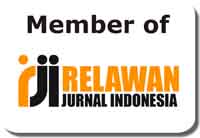“Is that holy soup?” Analyzing Translation Procedures of Indonesian Traditional Food
Abstract
Translating traditional cuisine terms from the source language to the target language needs to be conducted appropriately to avoid the loss of meaning. In this sense, comprehending the procedures used to translate traditional cuisine terms can provide more insights for translators and educators in the translation field. Hence, the current research examined the procedures used in translating a set of Indonesian traditional food terms into English. This study used a qualitative descriptive research design with an emphasis on cultural analysis. The present study applied Newmark's typology of translation procedures to analyze a series of translated texts of Indonesian traditional food on a website. The results suggest that seven translation procedures (descriptive equivalent, literal translation, expansion, functional equivalent, cultural equivalent, and couplets) were used to translate the data. Furthermore, the results imply that the use of translation procedures as well as the translator’s ideology have a significant impact on the translation results. In addition, it is significant for a translator to know the cultures of the target language and the source language to render appropriate translation results that can be understood by the intended readers. Besides that, it seems important for researchers to investigate the reasons behind the translators’ preferences in choosing certain procedures to develop translation texts in the target language.
Keywords
Full Text:
PDFReferences
Abarca, R. M. (2021). Strategi penerjemahan teks Bahasa Inggris ke Bahasa Indonesia calon mahasiswa magister dalam ujian masuk program pascasarjana UIN Ar-Raniry Banda Aceh. Nuevos Sistemas de Comunicación e Información, 4(2), 2013–2015.
Abbasi, A., & Koosha, M. (2016). Exploring expansion and reduction strategies in two English translations of Masnavi. Advances in Language and Literary Studies, 7(2), 219–225. https://doi.org/10.7575/aiac.alls.v.7n.2p.219
Al Saleh, R. A. (2019). An application of Newmark’s procedures to Muhammad Abul Qui’s English translation of Mohammad al-Ghazali’s Islamic guidance. Arab World English Journal, 225, 1–59. https://doi.org/10.24093/awej/th.225
Amenador, K. B., & Wang, Z. (2022). The translation of culture-specific items (CSIs) in Chinese-English food menu corpus: A study of strategies and factors. SAGE Open, 12(2). https://doi.org/10.1177/21582440221096649
Baumgarten, S., Gambier, Y., & van Doorslaer, L. (2012). Ideology and translation. In Handbook of Translation Studies (Vol. 3, pp. 59–65). https://doi.org/10.1075/hts.3.ide1
Behzadi, F., & Suzani, S. M. (2016). A study of the effect of the translator’s religion on the translation of eschatological terms in the Holy Qur’an by Newmark’s procedures. International Academic Journal of Humanities, 3(11), 13–24.
Bian, J., & Li, X. (2022). The interaction between ideology and translation. Proceedings of the 2021 International Conference on Education, Language and Art (ICELA 2021), 637. https://doi.org/10.2991/assehr.k.220131.080
Chandra, K., Suhartono, L., & Rosnija, E. (2016). An analysis on students’ translation procedure of idiom in narrative text. Jurnal Pendidikan dan Pembelajaran Untan, 5(4), 1–10.
Daghoughi, S., & Hashemian, M. (2016). Analysis of culture-specific items and translation strategies applied in translating Jalal Al-Ahmad’s by the pen. English Language Teaching, 9(4), 171–185. https://doi.org/10.5539/elt.v9n4p171
de Vooght, D. (2016). Royal Taste: Food, Power and status at the European Courts after 1789. Royal Taste: Food, Power and Status at the European Courts after 1789. https://doi.org/10.4324/9781315607078
Farahani, M. V. (2013). The role of discourse analysis in translation. International Journal of Applied Linguistics and English Literature, 2(1), 112–116. https://doi.org/10.7575/ijalel.v.2n.1p.112
Farkhan, M., Naimah, L. U., & Suriadi, M. A. (2020). Translation strategies of food-related culture specific items in indonesian subtitle of netflix series the final table. Insaniyat: Journal of Islam and Humanities, 4(2), 149–162. https://doi.org/10.15408/insaniyat.v4i2.14668
Fauzia, M. R. (2021). Annotated translation of curriculum terminology in Indonesian academic transcript. Journal of English for Academic and Specific Purposes (JEASP), 4(2), 228–242. https://doi.org/10.18860/jeasp.v4i2.14429
Glynn, D. (2021). Outline of a theory of non-translation. Across Languages and Cultures, 22(1), 1–13. https://doi.org/10.1556/084.2021.00001
Glynn, D. (2021). Qualitative research methods in translation theory. SAGE Open, 11(3), 1–7. https://doi.org/10.1177/21582440211040795
Grant, L. S. (2017). Ideology of translation concept approach on determining a decision by the translator. Linguistics and Culture Review, 1(11), 1–12. https://doi.org/10.37028/lingcure.v1n1.1
Gumilar, H. (2017, November 12). Makanan Indonesia dalam Bahasa Inggri. https://Penerjemah-Id.Com/2017/11/12/Makanan-Indonesia-Dalam-Bahasa-Inggris/.
Hadithya, O. (2014). Translation procedures used in translating computer terms from English into Bahasa Indonesia. Vivid: Journal of Language and Literature, 3(2), 1–15.
Hakam, M. A. (2017). Sense and reference in translation of Indonesian dish names.
Halverson, S. L. (2015). Cognitive translation studies and the merging of empirical paradigms. Translation Spaces, 4(2), 310–340. https://doi.org/10.1075/ts.4.2.07hal
Ho, S. S., Holloway, A., & Stenhouse, R. (2019). Analytic methods’ considerations for the translation of sensitive qualitative data from Mandarin Into English. International Journal of Qualitative Methods, 18, 1–16. https://doi.org/10.1177/1609406919868354
Hou, Y., Sun, Y., & Li, F. (2020). A comparative study of Emma from the perspective of feminist translation studies. International Journal of Arts and Commerce, 9(7), 1–11.
Jin, D. O., & Nida, E. (2006). On translation: An expanded edition (1st ed., Vol. 1). City University of HK Press.
Larson, M. L. (1998). Meaning-based translation: A guide to cross-language equivalence. Paper Knowledge. Toward a Media History of Documents (Vol. 1).
Lewis, D., & Gentzler, E. (1995). Contemporary translation theories. The Modern Language Review, 90(2), 400. https://doi.org/10.2307/3734551
Mahmud, E. Z. (2022). The Translation of the most popular Indonesian food into English in novels. International Journal of Social Science and Human Research, 5(2), 543–550. https://doi.org/10.47191/ijsshr/v5-i2-20
Mahmud, E. Z., Ampera, T., Sidiq, I. I. (2020). Indonesian dishes in the English target novel. International Journal of Linguistics, Literature and Translation, 3(12), 115–123. https://doi.org/10.32996/ijllt.2020.3.12.15
McClements, D. J. (2023). The past is the future: Tofu and Tempeh rejuvenated. In Meat Less: The Next Food Revolution (1st ed., Vol. 1, pp. 213–237). Springer.
Marco, J. (2019). The translation of food-related culture-specific items in the Valencian Corpus of translated literature (COVALT) corpus: a study of techniques and factors. Perspectives: Studies in Translation Theory and Practice, 27(1), 1–22. https://doi.org/10.1080/0907676X.2018.1449228
Mashhady, H., Pourgalavi, M., & Fatollahi, M. (2015). Newmark’s procedures in Persian translation of Golding’s Lord of the Flies. International Journal of English Language & Translation Studies, 3(1), 57–69.
Newmark, P. (1988). A textbook of translation. In Text (Vol. 1).
Pitaloka, A. Y., Adam, M., & Prautomo, A. (2018). The equivalence of cultural word translation in the novel Child of All Nations by Max Lane. Prologue: Journal of Language, Literature and Cultural Studies, 4(1), 65-87.
Putranti, A. (2015). Synonymy: A Translation Procedure to Overcome Problems of SL and TL Cultural Differences. Journal of Language and Literature, 15(2), 168–172. https://doi.org/10.24071/joll.v15i2.201
Putri, D. (2014). Translation procedures of medical terms in the book entitled Stress Less. Linguistika, 21(41), 1–14.
Rasul, S. H. (2016). Translation constraints and procedures to overcome them in rendering journalistic texts. Journal of University of Human Development, 2(3), 402. https://doi.org/10.21928/juhd.v2n3y2016.pp402-419
Riecher, V. (2019). Literal translation: A study with several translation techniques to get a good translation result. Applied Translation, 31–37. https://doi.org/10.51708/apptrans.v13n2.810
Salsabila, R., & Jumanto, J. (2020). Translation strategies for cultural expressions in Indonesia’s inflight magazine “Colors.” Jurnal Basis, 7(1), 185–198. https://doi.org/10.33884/basisupb.v7i1.1899
Srinawati, W., & Fuzianti, Y. (2020). An analysis of English-Indonesian translation procedure on narrative text. Journal of English Education, 3(2), 1–14.
Subhan, R. F. (2016). Strategi penerjemahan Bahasa Indonesia ke dalam Bahasa Arab; teks kemasan produk makanan ringan.
Tanudirjo, K. R. (2020). The English translation of food menu In three restaurants In Yogyakarta: the acceptability and the strategy.
Toury, G. (2012). Descriptive translation studies – and beyond (1st ed., Vol. 1). Benjamins Translation Library.
Trisnawati, I. K., & Bahri, S. (2017). Strategi penerjemahan teks bahasa Inggris ke bahasa Indonesia calon mahasiswa magister dalam ujian masuk program pascasarjana UIN Ar-Raniry Banda Aceh. Getsempena English Education Journal, 4(2), 84–100.
van Nes, F., Abma, T., Jonsson, H., & Deeg, D. (2010). Language differences in qualitative research: Is meaning lost in translation? European Journal of Ageing, 7(4), 313–316. https://doi.org/10.1007/s10433-010-0168-y
Venuti, L. (2018). The translator’s invisibility: A history of translation. In The Translator’s Invisibility: A History of Translation. https://doi.org/10.4324/9781315098746
Yamananda, I. (2017, December 8). 6 terjemahan Bahasa Inggris asal-asalan makanan Indonesia ini bikin ngakak so hard, mana favoritmu? Tribunstyle.
Yingmin, T., & Malini, N. L. N. S. (2021). Translation strategies applied in culinary culture-specific items. The International Journal of Language and Cultural (TIJOLAC), 3(2), 18–28.
DOI: http://dx.doi.org/10.31332/lkw.v0i0.7013
Copyright (c) 2023 Reza Anggriyashati Adara, Dini Ditya Putri

This work is licensed under a Creative Commons Attribution-ShareAlike 4.0 International License.
Langkawi: Journal of The Association for Arabic and English indexed by:


















.png)
.png)

.png)
2.png)








